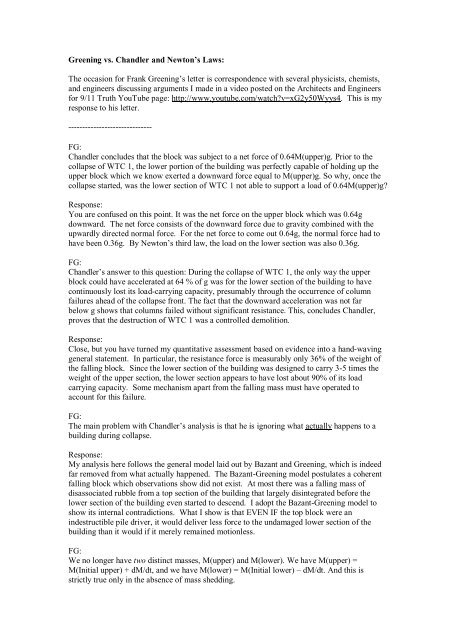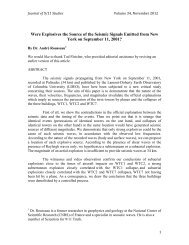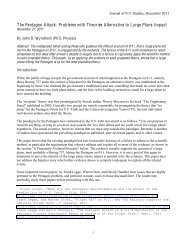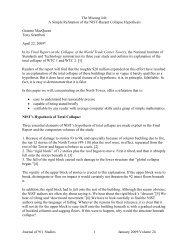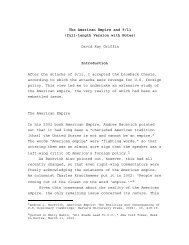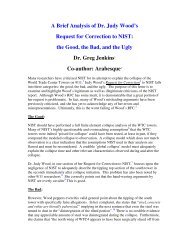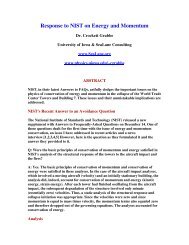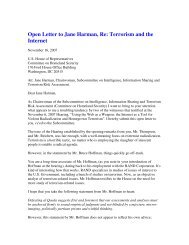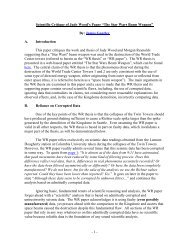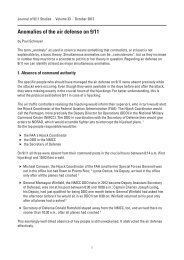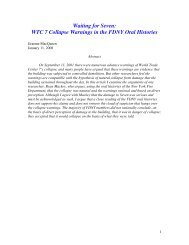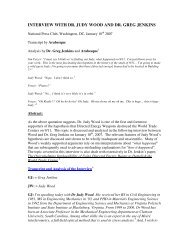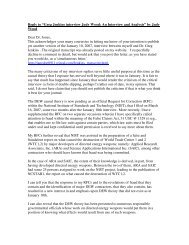David Chandler Responds to Frank Greening - Journal of 9/11 Studies
David Chandler Responds to Frank Greening - Journal of 9/11 Studies
David Chandler Responds to Frank Greening - Journal of 9/11 Studies
Create successful ePaper yourself
Turn your PDF publications into a flip-book with our unique Google optimized e-Paper software.
<strong>Greening</strong> vs. <strong>Chandler</strong> and New<strong>to</strong>n’s Laws:<br />
The occasion for <strong>Frank</strong> <strong>Greening</strong>’s letter is correspondence with several physicists, chemists,<br />
and engineers discussing arguments I made in a video posted on the Architects and Engineers<br />
for 9/<strong>11</strong> Truth YouTube page: http://www.youtube.com/watch?v=xG2y50Wyys4. This is my<br />
response <strong>to</strong> his letter.<br />
------------------------------<br />
FG:<br />
<strong>Chandler</strong> concludes that the block was subject <strong>to</strong> a net force <strong>of</strong> 0.64M(upper)g. Prior <strong>to</strong> the<br />
collapse <strong>of</strong> WTC 1, the lower portion <strong>of</strong> the building was perfectly capable <strong>of</strong> holding up the<br />
upper block which we know exerted a downward force equal <strong>to</strong> M(upper)g. So why, once the<br />
collapse started, was the lower section <strong>of</strong> WTC 1 not able <strong>to</strong> support a load <strong>of</strong> 0.64M(upper)g?<br />
Response:<br />
You are confused on this point. It was the net force on the upper block which was 0.64g<br />
downward. The net force consists <strong>of</strong> the downward force due <strong>to</strong> gravity combined with the<br />
upwardly directed normal force. For the net force <strong>to</strong> come out 0.64g, the normal force had <strong>to</strong><br />
have been 0.36g. By New<strong>to</strong>n’s third law, the load on the lower section was also 0.36g.<br />
FG:<br />
<strong>Chandler</strong>’s answer <strong>to</strong> this question: During the collapse <strong>of</strong> WTC 1, the only way the upper<br />
block could have accelerated at 64 % <strong>of</strong> g was for the lower section <strong>of</strong> the building <strong>to</strong> have<br />
continuously lost its load-carrying capacity, presumably through the occurrence <strong>of</strong> column<br />
failures ahead <strong>of</strong> the collapse front. The fact that the downward acceleration was not far<br />
below g shows that columns failed without significant resistance. This, concludes <strong>Chandler</strong>,<br />
proves that the destruction <strong>of</strong> WTC 1 was a controlled demolition.<br />
Response:<br />
Close, but you have turned my quantitative assessment based on evidence in<strong>to</strong> a hand-waving<br />
general statement. In particular, the resistance force is measurably only 36% <strong>of</strong> the weight <strong>of</strong><br />
the falling block. Since the lower section <strong>of</strong> the building was designed <strong>to</strong> carry 3-5 times the<br />
weight <strong>of</strong> the upper section, the lower section appears <strong>to</strong> have lost about 90% <strong>of</strong> its load<br />
carrying capacity. Some mechanism apart from the falling mass must have operated <strong>to</strong><br />
account for this failure.<br />
FG:<br />
The main problem with <strong>Chandler</strong>’s analysis is that he is ignoring what actually happens <strong>to</strong> a<br />
building during collapse.<br />
Response:<br />
My analysis here follows the general model laid out by Bazant and <strong>Greening</strong>, which is indeed<br />
far removed from what actually happened. The Bazant-<strong>Greening</strong> model postulates a coherent<br />
falling block which observations show did not exist. At most there was a falling mass <strong>of</strong><br />
disassociated rubble from a <strong>to</strong>p section <strong>of</strong> the building that largely disintegrated before the<br />
lower section <strong>of</strong> the building even started <strong>to</strong> descend. I adopt the Bazant-<strong>Greening</strong> model <strong>to</strong><br />
show its internal contradictions. What I show is that EVEN IF the <strong>to</strong>p block were an<br />
indestructible pile driver, it would deliver less force <strong>to</strong> the undamaged lower section <strong>of</strong> the<br />
building than it would if it merely remained motionless.<br />
FG:<br />
We no longer have two distinct masses, M(upper) and M(lower). We have M(upper) =<br />
M(Initial upper) + dM/dt, and we have M(lower) = M(Initial lower) – dM/dt. And this is<br />
strictly true only in the absence <strong>of</strong> mass shedding.
Response:<br />
The equations you have written are clearly in error since the units <strong>of</strong> the terms do not even<br />
agree. It appears that you are trying <strong>to</strong> say, in pseudo-calculus terms, that the falling mass<br />
can be considered <strong>to</strong> grow as it sweeps up material that is crushed at the interface. I comment<br />
on the sloppiness <strong>of</strong> your equations because what I see you doing repeatedly is using<br />
mathematics <strong>to</strong> muddle the issue rather than clarify it. The reader shouldn’t have <strong>to</strong> come <strong>to</strong><br />
the rescue and infer what you probably mean by your equations. It is interesting that you do<br />
acknowledge that there is a neglected term for mass shedding which you do not attempt <strong>to</strong><br />
quantify. Given that a majority <strong>of</strong> the mass <strong>of</strong> the building lands outside its footprint, this<br />
seems like a major oversight.<br />
FG:<br />
Obviously this situation greatly complicates momentum transfer calculations because you<br />
have <strong>to</strong> include a dM/dt term as well as a dv/dt (acceleration) term. I challenge<br />
<strong>David</strong> <strong>Chandler</strong> <strong>to</strong> re-do his WTC 1 collapse analysis with inclusion <strong>of</strong> a dM/dt term.<br />
Response:<br />
I have already done these calculations and they are included in my paper on the downward<br />
acceleration <strong>of</strong> WTC1 which is undergoing peer review for another journal, so cannot yet be<br />
published here. I assume the reason you throw this down as a challenge <strong>to</strong> me is you assume,<br />
wrongly, that turning this in<strong>to</strong> a variable mass problem will “greatly complicate” the issue.<br />
Actually, it does not greatly complicate the issue. It takes only a few extra lines <strong>to</strong> modify the<br />
analysis. Briefly, the accreted mass is initially at rest, so it adds inertia but no momentum <strong>to</strong><br />
the upper block. The net result is that the accretion <strong>of</strong> mass results in a DECREASE in the<br />
force <strong>of</strong> interaction with the lower section <strong>of</strong> the building. I might also note that the fact that<br />
you would challenge me <strong>to</strong> demonstrate something that actually strengthens my argument is<br />
pretty clear evidence that you have not done, and perhaps you are not able <strong>to</strong> do, the analysis<br />
yourself. Nevertheless you “up the ante.” You brush aside adverse conclusions based on a<br />
simple model and seek refuge in a more complex model, even though you have not followed<br />
through and investigated the implications <strong>of</strong> the more complex model yourself. I must<br />
emphasize again that I am using YOUR model, which requires a rigid falling block. I adopt it<br />
<strong>to</strong> show its flaws, but it is your model nonetheless.<br />
FG:<br />
I note <strong>to</strong>o that <strong>Chandler</strong> gives no consideration <strong>to</strong> energy transfer in the collapse <strong>of</strong> WTC 1 &<br />
2. Energy balance requires that:<br />
a = g – E1/3.7M(upper), ……….. where E1 is the energy needed <strong>to</strong> collapse one floor<br />
Response:<br />
Multiply this equation through by M and you get Ma = Mg – F, where F is the average force<br />
<strong>of</strong> resistance. This is exactly the equation I use in my analysis. Con<strong>to</strong>rting it around <strong>to</strong><br />
express the force in terms <strong>of</strong> energy adds nothing <strong>to</strong> the analysis. It is certainly not any kind<br />
<strong>of</strong> “energy balance” and it does not represent something I have left out <strong>of</strong> my analysis.<br />
FG:<br />
The fact that a is observed <strong>to</strong> be approximately constant means E1/M is also ~ constant. That<br />
E1/M should be more or less constant is consistent with the design <strong>of</strong> WTC 1 & 2, or indeed<br />
any tall building.<br />
Response:<br />
All you are doing is agreeing with me that the acceleration is approximately constant for the<br />
period under observation, which proves that the resistive force is approximately constant.<br />
There is nothing pr<strong>of</strong>ound in this. In fact it is an artifact <strong>of</strong> the Bazant/<strong>Greening</strong> assumption<br />
2
that the upper block remains intact. The significant thing, as I’ve shown, is that the force <strong>of</strong><br />
resistance is significantly less than the weight <strong>of</strong> the falling block. If you assume the upper<br />
block is accreting mass, as you have challenged me <strong>to</strong> consider, even the statement that the<br />
resisting force is constant is no longer true.<br />
FG, in a lengthy paragraph, shortened here:<br />
When I say that E1 is “the energy <strong>to</strong> collapse one floor” please note that E1 includes all the<br />
energy consumed during the descent <strong>of</strong> the upper block through one floor height (~ 3.7<br />
meters). Etc. …. Thus we see that E1/M is indeed approximately constant for the floors <strong>of</strong><br />
interest.<br />
Response:<br />
You are using circular reasoning. You are not dealing with the reality. You are dealing with<br />
consequences <strong>of</strong> your simplifying assumptions. More <strong>to</strong> the point, none <strong>of</strong> this is relevant <strong>to</strong><br />
the issue at hand. I have laid out a clear, coherent argument that the falling block could not<br />
deliver the force needed <strong>to</strong> crush the bot<strong>to</strong>m section <strong>of</strong> the building while it continued <strong>to</strong><br />
accelerate downward. None <strong>of</strong> what you say in the previous paragraph or the remainder <strong>of</strong><br />
your letter even addresses this issue.<br />
FG:<br />
On the question <strong>of</strong> energy transfer, deceleration and all that, I would say…etc.<br />
Response:<br />
What on earth do you mean by “energy transfer, deceleration, and all that…”? Many <strong>of</strong> the<br />
fragments in this paragraph are true enough, but they don’t go anywhere. They don’t advance<br />
your argument. They don’t challenge mine. They are not illuminating. There’s nothing here<br />
<strong>to</strong> respond <strong>to</strong>.<br />
FG:<br />
The collapse <strong>of</strong> WTC 1 is best studied by considering how potential energy was converted <strong>to</strong><br />
kinetic energy and dissipated at the crush front and subsequently within the steadily growing<br />
debris/rubble layer. This debris layer was not only a sink for potential energy, but a source <strong>of</strong><br />
random fluctuations in the motions <strong>of</strong> the individual debris particles. These fluctuations<br />
cannot exert a net resultant force against the downward motion <strong>of</strong> the upper block but rather<br />
serve <strong>to</strong> control the gravitational work rate. In fact, if this type <strong>of</strong> collapse should attain a state<br />
<strong>of</strong> dynamic equilibrium, there will be a balance between the production <strong>of</strong> fluctuation energy<br />
at the crush front and the conversion <strong>of</strong> this energy <strong>to</strong> heat within the debris layer through the<br />
dissipating effects <strong>of</strong> many random collisions <strong>of</strong> debris particles. It is considerations such as<br />
these that help <strong>to</strong> quantify the complexities <strong>of</strong> the WTC 1 collapse, not naïve applications <strong>of</strong><br />
New<strong>to</strong>n’s 3 rd Law <strong>of</strong> motion.<br />
Response:<br />
You are engaging in pseudo academic obfuscation. In my video I have made the argument<br />
that the constant acceleration <strong>of</strong> the <strong>to</strong>p section <strong>of</strong> the building implies that the resistive force<br />
is much less than the weight <strong>of</strong> the falling block. If I’m wrong, show me how. You seem <strong>to</strong><br />
be hoping non-technical readers will assume what you have said is pr<strong>of</strong>ound. It is not<br />
pr<strong>of</strong>ound. It is incoherent.<br />
Unsuspecting readers may not understand the significance <strong>of</strong> your last line. They should be<br />
informed that the reason you view the application <strong>of</strong> New<strong>to</strong>n’s 3 rd Law <strong>of</strong> motion as naïve, is<br />
because, as you have clearly and repeatedly stated in both private correspondence and public<br />
forums, that you believe New<strong>to</strong>n’s 3 rd Law does not apply <strong>to</strong> falling buildings. That, <strong>of</strong><br />
course, is utter nonsense. Your entire letter needs <strong>to</strong> be read and unders<strong>to</strong>od in the light <strong>of</strong><br />
this concluding statement. Your argument is not with me; it is with Isaac New<strong>to</strong>n.<br />
3


